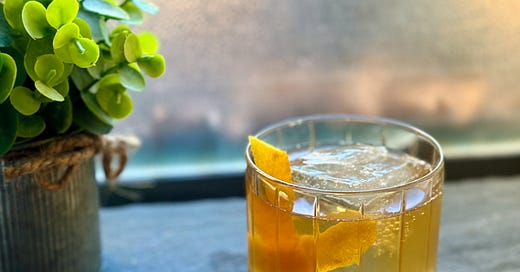Before the Old Fashioned, there was the Whiskey Cocktail. And almost as soon as there was a Whiskey Cocktail, there were variations, modifications, and “improvements” — small tweaks that generally stuck to the template but altered the drink with clever additions.
In the past, those variations were primarily the domain of professional bartenders with access to a wide selection of unusual imported ingredients. But today, home bartenders with modestly stocked bars can make their own similar alterations and improvements. And there’s no better place to start than with the original Improved Whiskey Cocktail.
Before you can improve a drink, however, it helps to understand the original.
First referenced in the 1800s, the Whiskey Cocktail was the great grandfather of cocktails as we now know them, the founder and CEO of cocktail nation.
Yes, there were spirit-heavy mixed drinks that preceded it, particularly punch, but the Whiskey Cocktail was the first libation to combine whiskey, sugar, and bitters in a single-serve drink.
In its earliest forms, the Whiskey Cocktail was somewhat rudimentary, a technology that had not yet been fully developed. It wasn’t quite an Old Fashioned. But it was the same fundamental idea, the general template for the drink we still enjoy today.
You can see that template in the first ever printed recipe for a Whiskey Cocktail, which appeared in the very first cocktail book: Jerry Thomas’ world-changing recipe book and barman’s manual, The Bartender’s Guide or How to Mix Drinks. It’s recipe number 109.
In this brief, loose recipe, you can see the essential form of the Old Fashioned as we drink it today.
There’s a heavy pour of whiskey, a couple dashes of a then-popular brand of bitters, plus a bit of “gum syrup” — a viscous combination of sugar, water, and gum arabic quite like the gum syrup found in this newsletter. There’s even the citrus peel for garnish. Yes, it’s lemon, rather than the more-common strip of orange peel we twist over our Old Fashioneds now; there are differences between this drink and what we now call an Old Fashioned. Yet as with the Wright Brothers’ airplane, which didn’t fly far but demonstrated the engineering concept, the essential idea is clearly there.
Years after his bar book came out, Thomas released an update. This one had a new — one might even say new and improved — recipe: The Improved Whiskey Cocktail.
To the original three-ingredient mix, Thomas added two dashes of maraschino and a single dash of absinthe.
In other words, the “improvements” were additions: herbal, anise-y absinthe, and sweet, fruity maraschino liqueur.
The Improved Whiskey Cocktail was a Whiskey Cocktail, but with some other interesting, unusual flavors added to the mix.
The Whiskey Cocktail, of course, eventually evolved into today’s Old Fashioned. So it’s no surprise that you can see that same additive technique in so many Old Fashioned variations that have appeared in the hundred-and-some years since.
Consider the Toronto, the first iteration of which appeared in the 1920s as the Fernet Cocktail. As I argued in last week’s newsletter, the Toronto is best understood as a rye Old Fashioned — but with an addition of Fernet-Branca. Earlier this week, we made a modest riff on the Toronto, which I named Blame Canada. It’s just a bourbon Old Fashioned—but with an addition of Amaro Nonino.
Part of what makes the Old Fashioned great is its ability to absorb and encourage variations. I have said this before, and I will no doubt say it again: The Old Fashioned isn’t just a singular drink or a specific recipe. It’s an idea, a concept, a technology, a philosophy, an endless formula for inspiration and enjoyment. It contains multitudes.
So this week, we’re going to go back in time and make an Improved Whiskey Cocktail. And then we’ll look at how to take this old variation and create new variations from it — including a smoky, peaty version that I find improves on the original.
Johnny Dash
Jerry Thomas’ Improved Whiskey Cocktail measured its additions of absinthe and maraschino liqueur in dashes, almost like bitters. It’s an old recipe that predates standardized measurements. So we have some choices to make about how to translate those dashes into contemporary measurements.
There are various ways to do this, but the main things to understand are:




